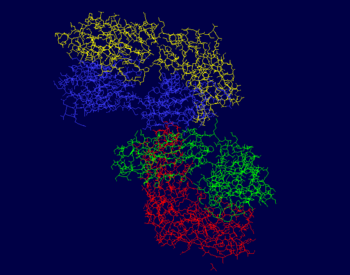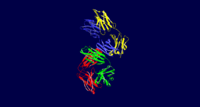Blue Luminescent Antibody Derived from House Mouse
From Proteopedia
IntroductionThe protein PDB 3CFB, or EP2-19G2, is a blue luminescent antibody with diverse applications, such as mercury sensing and DNA labeling [1]. 3CFB was first found in Mus musculus, or the common house mouse, with ties to immune system functions as it has a similar structure, domain, and folding to known immunoglobulins[2]. Both chains of this protein have an immune system-like structure. This protein, a monoclonal antibody, is typically found in complex with a trans-stilbene. Its luminescent quality makes its presence easy to identify, which makes it useful in biosensing applications. The signature glow is created from an electron transfer reaction from the trans-stilbene to a tryptophan in the antibody. This is unique due to its bluish color and the long duration of an especially bright light, since the light that this protein emits is magnitudes greater than comparable fluorescent compounds. It’s structure includes 864 residues with 4 separate chains, A, B, H, and L. Chains H and L are both sequentially unique to this protein. The A chain is pictured in yellow, the L chain in red, the B chain in blue, and the H chain in green.
Ligand InteractionsLigands of this protein include glycerol and 4-(4-Styryl-Phenyl Carbamoyl)-Butyric Acid[2]. In the figure, the three smaller molecules are the sites glycerol interaction and the larger molecules the site of 4-(4-Styryl-Phenyl Carbamoyl)-Butyric Acid. Glycerol is represented by GOL and 4-(4-Styryl-Phenyl Carbamoyl)-Butyric Acid is represented by SPB. GOL has significantly more conformations than SPB that can be bound by this protein, which is due to this protein having 3 separate binding sites for it. SPB only has two different conformations, and both are bound in the same binding pocket, although they are attached to two separate chains in the binding pocket. The four binding sites are shown in the linked figures, with example ligands in them. Note that one of the GOL binding sites is extremely close the the SPB binding site. The SPB binding site is on the deep interior of the protein, whereas all of the GOL binding sites are closer to the surface of the protein. GOL is bound by chains A, H, and L. SPB is bound by chains B and L. Specific ligand interactions are represented by SPB 301 L, GOL 402 L, GOL 406 L, GOL 405 H, GOL 401 A, GOL 403 A, GOL 404 A, and SPB 302 A. The first set of three letter is the ligand that is bound, the number represents the specific conformation of the ligand, and the last letter represents the chain being interacted with.
Light and Heavy Chains
The light chains of this protein include the A and L chains. The A chain is made up of 219 residues in total, and is an L polypeptide. The A chain has 3 helices composed of 11 residues, and 25 strands of beta sheets with 113 residues. This strand is 5% helical and 51% beta sheet, which means that 44% of this chain is not a part of a secondary structure. The L chain is also made up of 219 residues total, and is a L polypeptide. The L chain has 3 helices with 12 residues total, and 25 strands of beta sheets made up of 105 residues. This chain is 5% helical and 47% beta sheet, meaning that 48% of this chain is not part of a secondary structure. Chain A has binding sites for GOL A 403, GOL A 404, SPB B 302, and GOL A 401. Chain L has the binding sites for SPB L 301, GOL L 402, and GOL L 406. The heavy chains of this protein include the B and H chains. It is a total of 426 residues long. Both chains are 213 residues long and are L polypeptides. Chain B is 5% helical and 51% beta sheet, with 44% of its residues not having a secondary structure. Chain H is 5% helical and 50% beta sheet, with 45% of its residues not having a secondary structure. Chain B contains the binding site for SPB B 302, and Chain H has binding sites for both GOL H 405 and SPB L 301. The photos to the right show that the majority of this protein is composed of beta sheets with the occasional alpha helix, however a good portion of this protein is not a part of a secondary structure. In the first figure, the A chain is pictured in yellow, the L chain in red, the B chain in blue, and the H chain in green. In the second figure, alpha helices are pictured in red while beta sheets are shown in yellow. The portions of 3CFB that do not form a secondary structure are shown by white strands[2]
Debler, E. W., Kaufmann, G. F., Meijler, M. M., Heine, A., Mee, J. M., Pljevaljčić, G., … Lerner, R. A. (2008). Deeply Inverted Electron-Hole Recombination in a Luminescent Antibody-Stilbene Complex. Science, 319(5867), 1232–1235.[1]
Debler, E. W., & Wilson, I. A. (2008, March 18). 3CFB. Retrieved April 22, 2019, from https://www.rcsb.org/structure/3CFB[3] | |||||||||||



